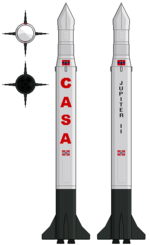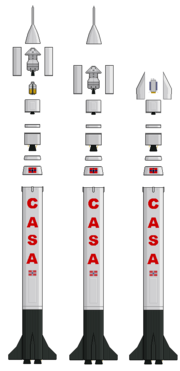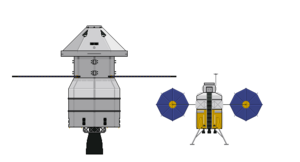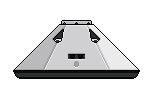Future Reusable Launch Rocket Initiative: Difference between revisions
(Created page with "===Development of the Jupiter I & Jupiter I-A Reusable Rocket=== 150 px|thumb|right|View of the standard, unmanned, Jupiter II(I-A) Rocket. By the year 1996, CASA was heavily reliant on expendable launch vehicles such as the Ariane 5, Atlas V, and Delta IV Heavy for its satellite deployment needs. However, the recurring expenses associated with these non-reusable rockets, including substantial royalty fees paid to corporations, posed sig...") |
m (Anagonia moved page Jupiter II Program to Future Reusable Launch Rocket Initiative: Changed to actual program name) |
||
| (2 intermediate revisions by the same user not shown) | |||
| Line 1: | Line 1: | ||
{{Region icon Esvanovia}} | |||
===Development of the Jupiter I & Jupiter I-A Reusable Rocket=== | ===Development of the Jupiter I & Jupiter I-A Reusable Rocket=== | ||
[[File:JupiterIIViewsRocket.png|150 px|thumb|right|View of the standard, unmanned, Jupiter II(I-A) Rocket.]] | [[File:JupiterIIViewsRocket.png|150 px|thumb|right|View of the standard, unmanned, Jupiter II(I-A) Rocket.]] | ||
Latest revision as of 16:48, 19 May 2024
Development of the Jupiter I & Jupiter I-A Reusable Rocket
By the year 1996, CASA was heavily reliant on expendable launch vehicles such as the Ariane 5, Atlas V, and Delta IV Heavy for its satellite deployment needs. However, the recurring expenses associated with these non-reusable rockets, including substantial royalty fees paid to corporations, posed significant financial burdens on the space program. Recognizing the need for a more cost-effective and sustainable solution, CASA Chief Administrator Lara Williamson initiated the Future Reusable Launch Rocket Initiative (FRLRI) in collaboration with the Confederate States Military, given the vital role of launch rockets in the satellite defense network.
Affectionately dubbed "the firefly project" by its participants, FRLRI aimed to develop reusable launch systems capable of reducing costs and improving efficiency. Under the leadership of Colonel Bailey Brown from the Confederate States Air Force, and Administrator Jason Pickman from CASA, the initiative drew inspiration from private industry space programs and existing launch technologies. The Jupiter I concept rocket emerged from this endeavor, combining elements from various designs to create an innovative and promising prototype.
In 1999, the first test-flight of the Jupiter I prototype took place but ended in a catastrophic explosion due to structural integrity issues stemming from the diverse array of components utilized. Despite the setback, the Military persisted, ordering the construction of two additional prototypes against CASA's objections. Colonel Brown, recognizing the risks, sought assistance from Administrator Jason Pickman to address safety concerns and procedural challenges. Following a period of internal dispute and negotiation, Colonel Brown assumed command of the project and collaborated closely with CASA to redesign and salvage the final Jupiter I prototype.
The resulting redesign, designated as the Jupiter I-A, saw improvements in launch procedures and system integrity. Although the launch was met with partial success, with the first stage failing to land as planned and the second stage failing to achieve a full orbit, it marked a significant step forward in the development process. Subsequent prototypes faced similar challenges, prompting Colonel Brown and CASA designers to refine their approach, ultimately leading to the birth of the Jupiter II concept rocket.
Development of the Jupiter II Resuable Rocket
The culmination of years of research and refinement, the Jupiter II stands as a testament to Anagonia's commitment to space exploration and technological advancement. Born from the lessons learned during the Jupiter I program, the Jupiter II represents a paradigm shift towards self-reliance and innovation in the aerospace industry.
Central to the development of the Jupiter II was a concerted effort to utilize solely Anagonian-made and designed components. Recognizing the pitfalls of relying on international partnerships for critical components, Anagonia's manufacturing and technology firms rose to the challenge, supplying unique and cutting-edge components tailored to the Jupiter II's requirements. This shift ensured greater control over quality and reliability, addressing the shortcomings that plagued its predecessor.
The Jupiter II is a three-stage-to-orbit rocket, featuring two reusable stages and a final expendable orbital stage. Notable design features include four reusable side boosters for heavier payloads, large fins on the first stage for enhanced stability, and a focus on recovery and reusability. Both the first and second stages are designed to deorbit for recovery, utilizing parachutes for safe landings in the Anagonian Ocean.
On April 11th, 2003, the first prototype of the Jupiter II was successfully launched, marking a significant milestone in Anagonia's space exploration endeavors. Subsequent prototypes demonstrated consistent performance and reliability, leading to formal approval by CASA and the Military in 2004. Full-scale production commenced in 2005, ushering in a new era of flexibility and efficiency in satellite deployment.
Standing slightly taller than the Sovereignty Launch Vehicle utilized for the Independence-class Space Shuttle, the Jupiter II complemented Anagonia's existing fleet of space vehicles, providing a cost-effective alternative for satellite launches. As of the present date, the Jupiter II remains in active production and regular use by CASA, offering customers a reliable and affordable solution for their space exploration needs.
Functions & Launch Procedures of the Jupiter II
Jupiter II: Typical Functions
- The Jupiter II serves as a versatile launch vehicle, offering two variants to accommodate varying payload requirements. The Jupiter II Standard is designed for satellite launches and light components, while the Jupiter II Heavy caters to heavier payloads that exceed the Standard's capabilities but do not necessitate a shuttle launch. Notably, the Jupiter II is not intended for crewed missions, focusing instead on unmanned satellite deployments.
Jupiter II: Special Functions
- In addition to standard satellite launches, the Jupiter II supports classified Military Launches, incorporating highly specialized components tailored to specific mission requirements. Furthermore, customers have the option to request additional modifications to the launch vehicle to meet the unique demands of their payloads.
Jupiter II: Launch Procedures
- Launch preparations for the Jupiter II follow a meticulous protocol, ensuring the proper functioning of systems and adherence to safety standards. Fueling begins two hours prior to launch, with technicians conducting thorough checks and tests throughout the countdown sequence. Final go or no-go decisions are made at T-minus one minute, with internal guidance procedures initiated in the final moments leading up to launch. At T-minus five seconds, all first-stage engines are ignited sequentially, initiating liftoff and propelling the Jupiter II into its designated trajectory.
Jupiter II: First-Stage Separation and Recovery
- Following the critical phase of Max Q, the Jupiter II's first stage initiates preparations for shutdown and separation. Throttling down its engines, the first stage disengages from the second stage, enabling the ignition of the second stage's single engine. Equipped with four fins atop its frame, the first stage utilizes onboard maneuvering thrusters to orient itself for recovery operations. Once properly aligned, the first stage executes an initial recovery burn using the central engine located at the base of the five-engine configuration. Subsequently, guided by its fins, the first stage descends engines-first towards a predetermined recovery point in the Anagonian Ocean. A final burn, typically executed between altitudes of 5000 and 3000 feet, precedes the deployment of parachutes, facilitating a controlled descent into the ocean for recovery.
Jupiter II: Second-Stage Separation and Recovery
- Upon separation from the first stage and fairing deployment of the third stage, the second stage's single engine performs the necessary burn to assist the third stage into orbit. Subsequently, the second stage undertakes a recovery burn akin to that of the first stage, albeit experiencing greater forces during reentry. A final burn, conducted typically between altitudes of 10,000 and 5,000 feet, is followed by the deployment of parachutes, ensuring a safe landing in the Anagonian Ocean at a predetermined recovery point.
Jupiter II: Final-Stage Separation, Orbit, and Deorbit Burnup
- Functioning as the "orbital stage," the third stage of the Jupiter II is tasked with propelling the payload into the desired orbit. Equipped with a specialized "pup" engine, the third stage maneuvers the cargo as needed, utilizing its monopropellant reserves for orbital adjustments or specific operations such as docking. Upon completion of its mission objectives, the third stage either releases its payload into orbit or concludes its operations, initiating a burn to safely deorbit and disintegrate in the Earth's atmosphere.
Manned Jupiter II Launch Procedures: Orbital and Lunar Missions
The manned launch procedures for the Jupiter II rocket, tailored for both orbital and lunar missions, ensure crew safety and mission success. Below are the comprehensive steps involved in launching astronauts aboard the Jupiter II for these distinct missions:
Pre-Launch Preparation
Orbital Mission:
- Technicians conduct meticulous system checks on the Jupiter II, focusing on the Dragon Command Service Module (CSM) and the Wyvern Lunar Excursion Module (LEM). Crew members undergo rigorous training and pre-flight preparations.
Lunar Mission:
- Additional checks are performed on the Wyvern LEM to ensure its readiness for the lunar surface. Crew members receive specialized training for lunar operations, including surface exploration and scientific tasks.
Crew Boarding
Orbital & Lunar Mission:
- At T-minus 30 minutes, astronauts board the Dragon CSM and strap into their seats. Final checks are made to verify connectivity with ground control and life support systems.
Launch Countdown
Both Missions:
- The go/no-go decision process is conducted, with additional scrutiny on crew safety systems, especially the launch escape system. Internal guidance procedures commence at T-minus 1 minute. At T-minus 5 seconds, all engines ignite, and the launch escape system is armed. Liftoff proceeds as planned, with emergency ejection systems ready to activate if necessary.
In-Flight Operations
Orbital Mission:
- Upon reaching orbit, crew members perform necessary checks and maneuvers to ensure the Dragon CSM's readiness for orbital operations, including rendezvous and docking procedures with target space stations. If no mission profile matches a docking of a station, crew will preform missions on board the CSM for the duration.
Lunar Mission:
- Following orbital insertion, the crew conducts trajectory corrections and prepares for the translunar injection burn. Once en route to the moon, crew members transition to the Wyvern LEM for lunar surface operations.
Return and Reentry
Orbital Mission:
- After completing mission objectives, the Dragon CSM conducts a deorbit burn to reenter the Earth's atmosphere safely. The heat shield protects the spacecraft during reentry, and parachutes deploy for a splashdown recovery.
Lunar Mission: Following lunar surface activities, the Wyvern LEM rendezvous with the Dragon CSM in lunar orbit. Crew members transfer back to the command module for the return journey to Earth. The Wyvern LEM remains with the CSM to provide crew comfort space until arrival near Earth orbit. Once arrived at Earth orbit, the Wyvern LEM is released once the Dragon CSM is on a return trajectory, allowing the LEM to burn up in the atmosphere safely. The Dragon CSM conducts a deorbit burn to reenter the Earth's atmosphere safely. The heat shield protects the spacecraft during reentry, and parachutes deploy for a splashdown recovery.
Recovery Operations
Emergency Recovery (Launchpad):
- In the event of a launchpad emergency before liftoff, the launch escape system activates, propelling the crew away from the rocket to safety. Recovery teams on standby rush to assist the crew and secure the area.
Emergency Recovery (Launch):
- If a critical issue arises during launch, the launch escape system triggers, separating the crew module from the rocket. Parachutes deploy to ensure a safe descent, and recovery vessels retrieve the crew from the ocean.
Emergency Recovery (Space):
- Should an emergency occur in space, the crew activates the launch escape system to separate from the rocket. Depending on the nature of the emergency, the Dragon CSM returns to Earth for a controlled reentry and splashdown, or the crew implements contingency plans for safe recovery by ground control.




